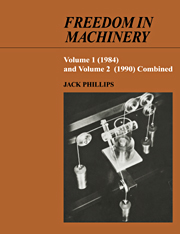Book contents
- Frontmatter
- Dedication
- Contents
- Preface
- General introduction
- 1 Mechanism and the mobility of mechanism
- 2 Overconstraint and the nature of mechanical motion
- 3 Some of the various lines in a moving body
- 4 Enumerative geometry and the powers of infinity
- 5 Rigidity and the instantaneous screw axis
- 6 Irregularity and the freedoms within a joint
- 7 The possibilities in reality for practical joints
- 8 Some elementary aspects of two degrees of freedom
- 9 The linear complex of right lines in a moving body
- 10 Line systems and the dual vectors in mechanics
- 11 Geometrical properties of the linear line systems
- 12 The vector polygons for spatial mechanism
- 13 On the two theorems of three axes
- 14 Some reciprocities across the middle number three
- 15 The generality and the geometry of the cylindroid
- 16 The discovery in a mechanism of a cylindroid
- 17 Action, notion, clearances and backlash
- 18 Singular events in the cycles of motion
- 19 Fundamental relations and some algebraic methods
- 20 The special geometry of some overconstrained loops
- 21 The helitangent lines in a moving body
- 22 The cylindroid in gear technology
- 23 The general and the special screw systems
- Bibliography
- Index of proper names
- Subject Index
3 - Some of the various lines in a moving body
Published online by Cambridge University Press: 07 September 2010
- Frontmatter
- Dedication
- Contents
- Preface
- General introduction
- 1 Mechanism and the mobility of mechanism
- 2 Overconstraint and the nature of mechanical motion
- 3 Some of the various lines in a moving body
- 4 Enumerative geometry and the powers of infinity
- 5 Rigidity and the instantaneous screw axis
- 6 Irregularity and the freedoms within a joint
- 7 The possibilities in reality for practical joints
- 8 Some elementary aspects of two degrees of freedom
- 9 The linear complex of right lines in a moving body
- 10 Line systems and the dual vectors in mechanics
- 11 Geometrical properties of the linear line systems
- 12 The vector polygons for spatial mechanism
- 13 On the two theorems of three axes
- 14 Some reciprocities across the middle number three
- 15 The generality and the geometry of the cylindroid
- 16 The discovery in a mechanism of a cylindroid
- 17 Action, notion, clearances and backlash
- 18 Singular events in the cycles of motion
- 19 Fundamental relations and some algebraic methods
- 20 The special geometry of some overconstrained loops
- 21 The helitangent lines in a moving body
- 22 The cylindroid in gear technology
- 23 The general and the special screw systems
- Bibliography
- Index of proper names
- Subject Index
Summary
Introduction
01. I define the meanings of and occasionally use in this chapter two contrived adjectives: motional and actional. I use the two adjectives to distinguish two different kinds of straight line. Both of these I call, not because they are both straight but because they share another important characteristic, right lines. I speak about (a) motional right lines, and (b) actional right lines. The definition of the first kind of line comes from within the kinematics of its circumstance, while that of the second springs from the statics. The two kinds of line are similar and closely related with one another. At the beginning, to avoid confusion, I shall speak about them separately; I begin by discussing (a) the motional right line. I continue to do that until we reach § 3.43. For the sake of brevity throughout the passages leading up to § 3.43, however, I call the motional right line by its shorter name, which is common to both of the lines, right line. A right line in a moving body is any straight line which joins two points in the body whose linear velocities are perpendicular to the line. Along any such right line all points have linear velocities perpendicular to the line (§ 5.26, § 21.08); the tips of all of the attached velocity vectors along the line are in a straight line also (§ 5.25); there is an oo3 of right lines at an instant (§ 9.29); and, for a note about the terminology, please refer to § 10.50. I choose the simple, movable mechanism whose description follows as a vehicle for argument. The mechanism has four links and its mobility is unity (§ 1.34).
- Type
- Chapter
- Information
- Freedom in Machinery , pp. 44 - 59Publisher: Cambridge University PressPrint publication year: 2007



